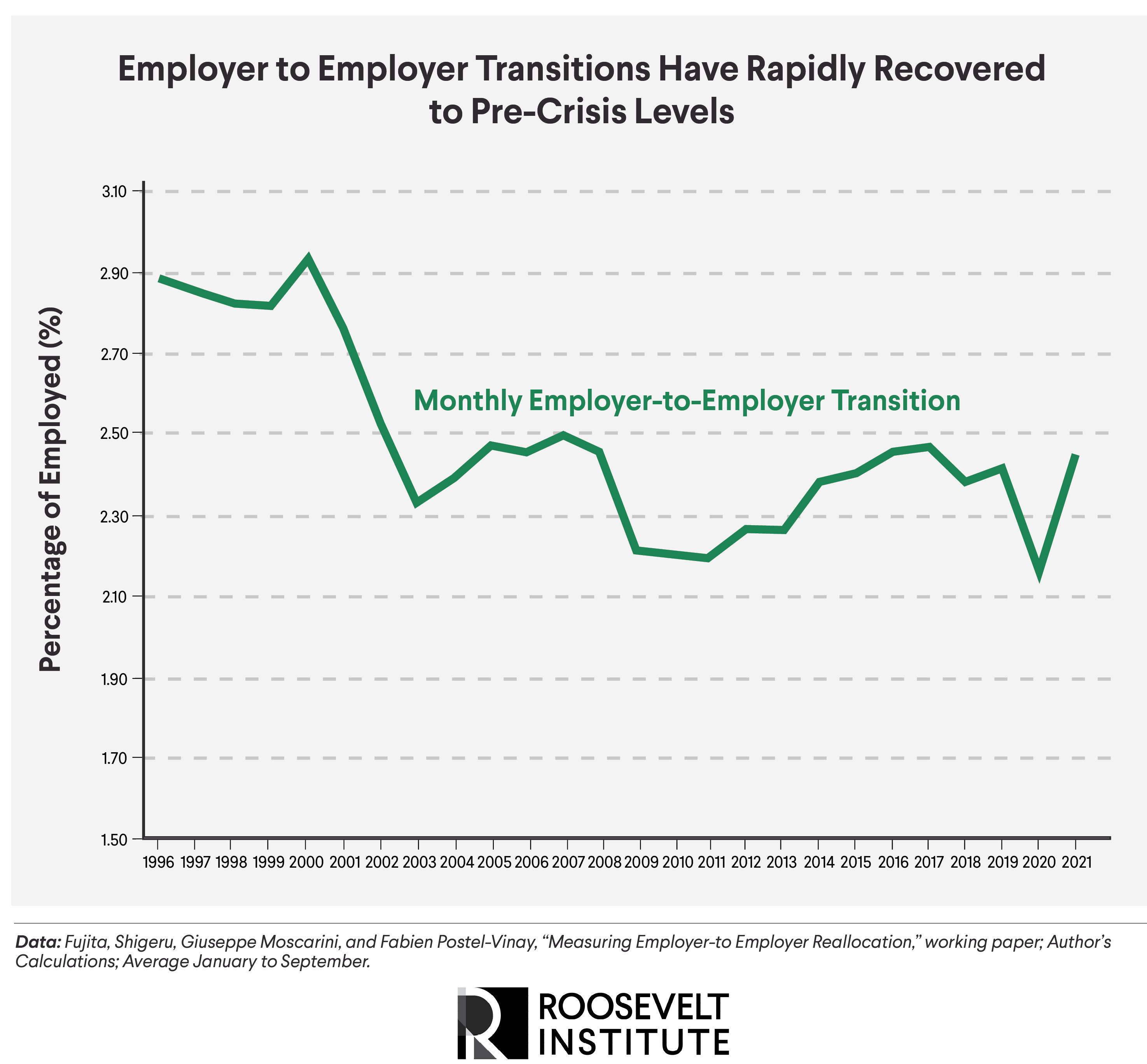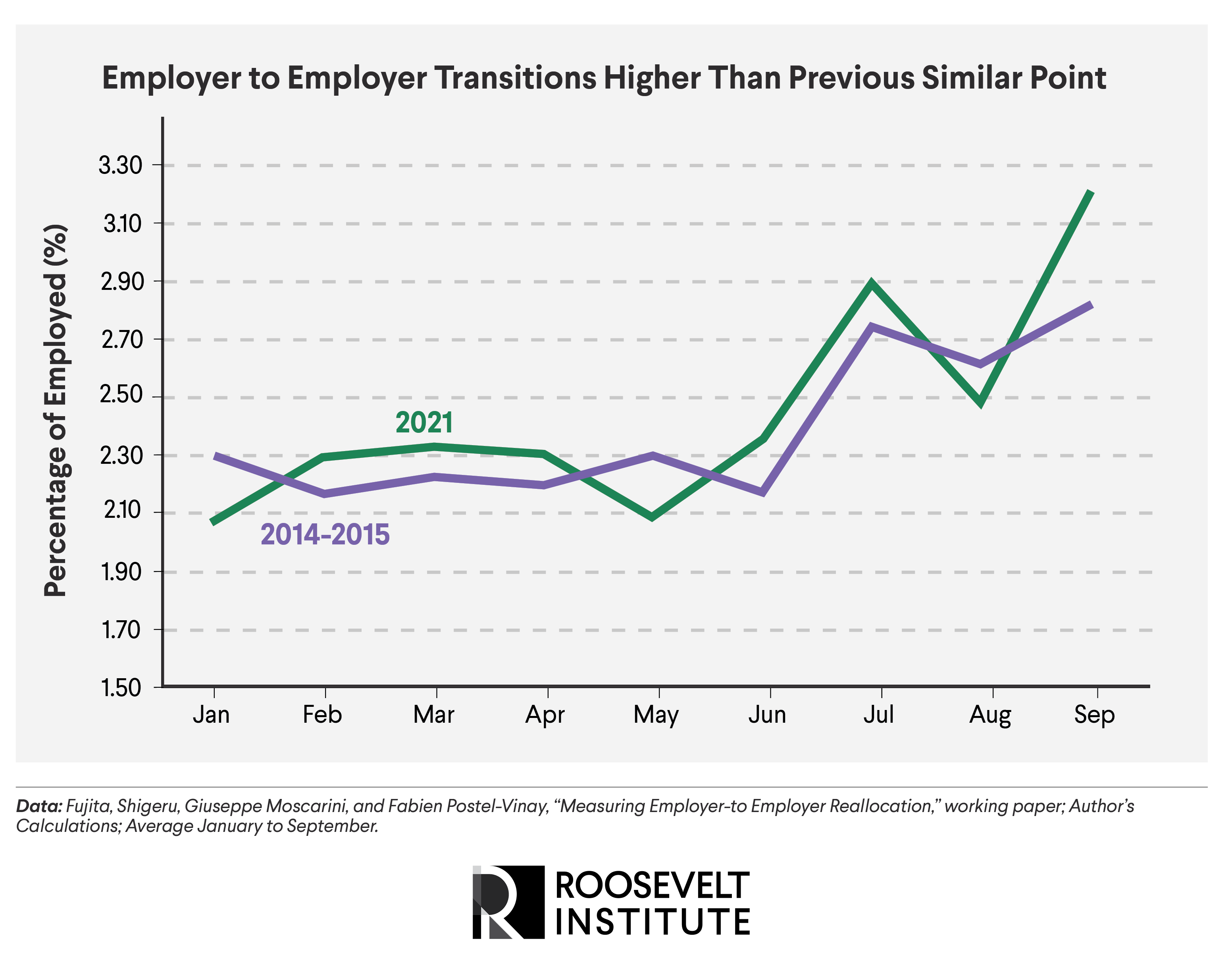What the Resurgence in Employer-to-Employer Transitions Tells Us about Today’s Labor Market
October 19, 2021
By Mike Konczal
The dynamics within the labor market remain puzzling this year, with record numbers of people quitting their jobs, unfilled job openings, and nominal wage growth. Trying to make sense of these trends, researchers and reporters have offered varied explanations: a broken, automated hiring system unsuited for this job market (Rani Molla and Emily Stewart, Vox); a conceptual crisis for the nature of work (Anna North, Vox); and a “Great Resignation” (coined by business professor Anthony Klotz) resulting from job burnout and a different sense of identity around work people have following the trauma of the COVID pandemic.
There’s not going to be one answer, and there’s a significant amount of truth to these stories. But this moment, also described as being filled with “labor shortages,” is also a period of record hiring rates, the largest of the 21st century. One underreported fact that bridges these phenomena: a significant recovery in the amount of people moving from one employer to another without ever being recorded as unemployed in-between.
Employer-to-employer transitions (“EE transitions”) have returned to pre-crisis levels and are higher than when unemployment was previously at its current level. Unlike when people who are unemployed or not in the labor force find jobs, these EE transitions create a quit event, a hire event, and likely a new job opening (for the previous job the person had) at the same time, and are more likely to involve a higher wage through better matching and labor market dynamism. This surge in employed people finding jobs is notable throughout 2021 and is an important additional answer to these open labor market questions. EE transitions get lost between the Job Openings and Labor Turnover Survey (JOLTS) and Current Population Survey (CPS) that are used to study this part of the labor market, so it’s important to find them, because they are important to both this recovery and the overall health of the labor market.
How to Measure the Missing Hires
Though generally not covered when people discuss the monthly job numbers, the CPS does report the number of people who “flow” or “transition” between being employed, unemployed, and outside of the labor force each month (last month, historical, FRED). Because the CPS is monthly, it does a good job of catching people who move around the labor market compared to various annual or quarterly surveys. However, it doesn’t include a measure of people who stay employed but with a new employer within the same month.
Starting with the revamped survey in 1994, the CPS began asking people who were employed both in the current and previous month: “Last month, it was reported that (name/you) worked for (company name). (Do/Does) (you/he/she) still work for (company name)?” In 2004, Federal Reserve economists Bruce Fallick and Charles Fleischman used this to create a data series measuring EE transitions. Starting in 2008, a privacy element in the survey allowing for people to not answer the company’s name led to almost 10 percent of eligible respondents not answering this question. Economists Shigeru Fujita, Giuseppe Moscarini, and Fabien Postel-Vinay (FMP) created a method to impute the missing values, and their EE transition data series is the current standard that I’ll use (you can see their methodology here, and get their FMP data series here).
Looking at the employer-to-employer transitions in the FMP data, here averaged from January through September, for each year shows us this:

Three things stand out.
- There’s a severe drop-off in EE transitions in the 21st century, part of a general decline in labor market dynamism consistent with a persistently demand-deficient environment (see Konczal and Steinbaum 2016 for a summary).
- EE transitions are procyclical, falling in recessions and increasing in recoveries.
- EE transitions have returned to pre-crisis levels. EE transitions are now at a level associated with unemployment well below 4 percent, even as headline unemployment is at 4.8 percent (and higher adjusted for labor force participation).
There’s still a lot of interesting, ongoing work on the procyclical nature of EE transitions, and as such it’s unclear what the right baseline comparison point for 2021 is. Should it be the unemployment rate, a flow rate, or a rate associated with JOLTS data? Should we be comparing this recovery to 2009–2010 or later?
For these purposes, we are going to look at unemployment. The unemployment levels we have seen over the course of 2021 are consistent with the 2014–2015 period, where the latter’s unemployment ranged from 6.6 to 5 percent. The next chart will look at EE transitions by month for this year compared with an average of 2014–2015 (the general comparison is consistent with either year). Here we see:

The level of EE transitions across the year are much higher than the equivalent period in the Great Recession: roughly 80,000 more people a month this year compared to that period, with September seeing 575,000 additional transitions. Compared to the monthly average of 2009–2010, 2021 has an additional 354,000 EE transitions a month. But beyond that number, there are reasons these transitions have powerful impacts that are not easily captured.
Vacancy Chains and a Hopeful Development
To understand what makes these unique, we should look at the idea of vacancy chains, a concept popularized in economics by George Akerlof, Andrew Rose, and now–Treasury Secretary Janet Yellen back in 1988. Consider a company hiring for a job opening. They could hire someone not currently employed; this closes the job opening and ends the vacancy chain. Or they can hire someone already employed. This likely creates another job opening even as it closes the first one, as that former employer has to rehire the person who left. That action creates a link in the vacancy chain. This former employer again has the choice to close the second job opening by hiring someone unemployed or someone already employed. Doing the latter will create yet another job opening and extend the vacancy chain further still.
These EE transitions can get lost but also create interesting results in the data. Even as they have no net effect on the monthly jobs numbers, EE transitions create a quit and hire event. Our quit and hire numbers come from the JOLTS, which is an employer survey, and as such will see the quit event even as the CPS will not in the monthly jobs number. But the JOLTS does not know if that person quit into another job or quit into unemployment. These EE transitions also generally create a new job opening even as it closes one, given that former employees will need to be replaced. The EE transition also likely creates wage gains. To bring someone in who is already employed generally takes a wage increase, and the movement of jobs likely indicates productivity gains too as already-employed people find better matching for their skills.
This is also a positive development for the economy as a whole. Starting with (Topel and Ward 1992) there’s a body of work that finds the most important and durable wage gains in a person’s career are associated with moves between jobs. Recent research found these switching gains to be highly procyclical and to have dropped significantly in recent recessions; the Great Recession, for example, saw the median wage gain from switching employers fall to zero percent, with no net-worker reallocation to higher-wage firms (Wiczer 2016; Haltiwanger et al 2018). There’s also a body of work that argues this decline in dynamism means a weaker overall economy, as reallocating already-employed workers to more productive and profitable enterprises increases productivity growth and innovation (Foster et al. 2008; Davis/Haltiwanger 2014).
A Positive Development
Higher employer-to-employer job transitions create more quits at the same time they create more job openings and higher wage gains—three hallmarks of the 2021 labor market. These are encouraging trends for two reasons.
First, this high wage growth is associated with better matching among employers and employees, which should lead to better productivity and growth with time. More research needs to be done, but this kind of churn in the labor market is positive and will eventually create vacancy chains that close with the unemployed being hired.
And second, as we see in the initial graph, there’s a lot of upside to grow when it comes to these measures of labor market dynamism. The last 20 years were characterized by periods of declining labor market dynamism, with fewer job transitions and weaker wage gains for those who did move. Reversing these trends would be a remarkable achievement of this recovery.
There are many pieces of the labor market puzzle, but the swift return of already-employed people finding new jobs—for a change—reflects good, hopeful underlying trends.
